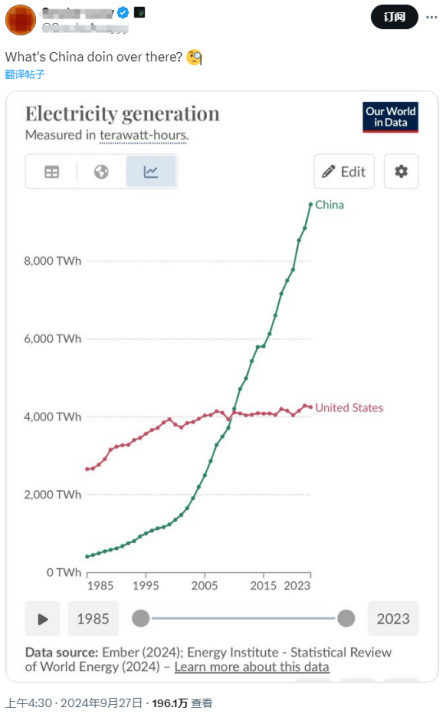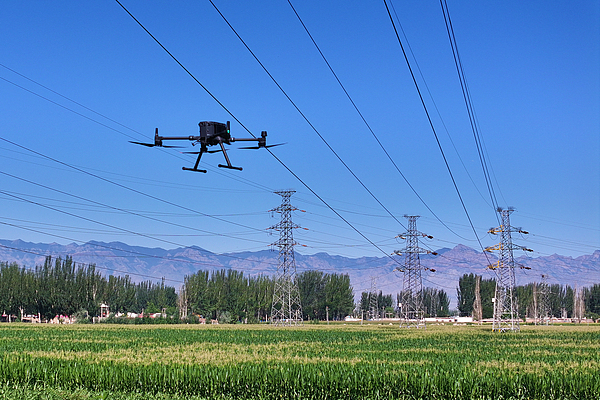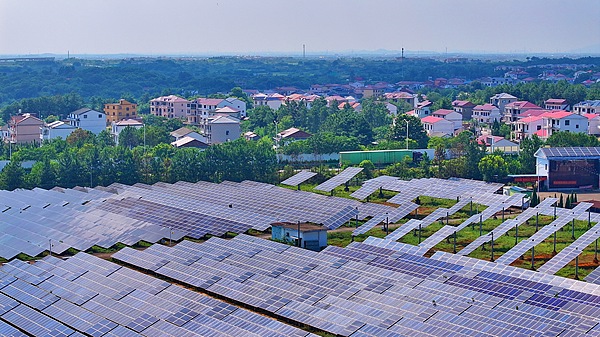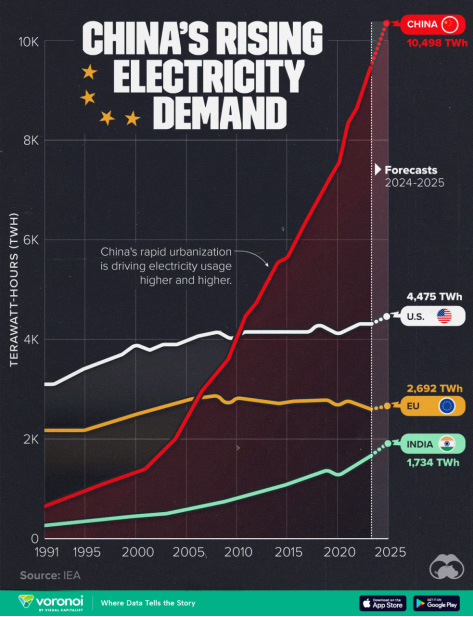On August 21, 2025, the National Energy Administration released a shocking figure: 102.26 billion kilowatt-hours.
This is China's total social electricity consumption in July, marking the first time in human history that a country's monthly electricity consumption has exceeded 100 billion kilowatt-hours.
It is equivalent to the total annual electricity consumption of the entire Association of Southeast Asian Nations (ASEAN) ten countries.
The netizens' reactions are interesting.
"This data would have caused power rationing a few years ago, but now it's really indifferent."
"Indifferent."
1
The most indifferent achievements are often the most remarkable ones.
Just like you wouldn't be overwhelmed with gratitude for breathing air today or for water flowing from the tap, the most basic guarantees in life are often taken for granted.
Ten years ago, it wasn't like this.
At the end of 2015, with the electrification of Guomao Village in Bama County, Golok Tibetan Autonomous Prefecture and Changjiang Village in Quemalai County, Yushu Tibetan Autonomous Prefecture, the last 39,800 people without electricity on the Chinese mainland finally had access to modern appliances.
While achieving full coverage of electricity across the country, the contradictions in the quantity and structure of power supply and consumption remained prominent, and power rationing was a common occurrence in many regions across the country during winter and summer each year.
In the cold wave at the beginning of 2010, coal reserves for power generation in central and eastern provinces were critically low, forcing Shanghai, Jiangsu, Hubei, and other key economic areas to implement power rationing.
Due to the extremely urgent power supply situation, the East China power grid, which had just recovered, mobilized 300,000 kW of low-peak power and a total of 74 million kWh to support the Central China power grid, avoiding a large-scale power outage at the critical moment.
This life-saving 74 million kWh was less than one ten-thousandth of the national electricity consumption of the previous month.
Now, even in record-breaking high temperatures and unprecedented electricity demand, our factories can still operate 24 hours a day, and every household's air conditioners continue to run without interruption. This composure behind it reflects a fundamental leap in the country's power security capability.
Remember last year in September, after attending the World Artificial Intelligence Conference (WAIC) held in China, AI expert Rui Ma returned to the U.S. with her team, and she commented: "In China, providing sufficient power for data centers is no longer an issue. This contrasts sharply with the United States, where the development of artificial intelligence is increasingly associated with debates over data center power consumption and grid limitations."

This year, after participating in the World Artificial Intelligence Conference (WAIC) held in China, AI expert Rui Ma (Rui Ma) who led her team back to the U.S. also remarked: "In China, providing sufficient power for data centers is no longer an issue. This is a sharp contrast with the U.S., where the development of artificial intelligence is increasingly linked to debates about data center power consumption and grid limitations."
Fortune magazine commented that Rui Ma's remarks seem to suggest that she believes "the competition may have already ended."
Data does not lie. China's power generation surpassed the U.S. in 2010, and by 2023, it had far exceeded the U.S. More importantly, even when calculated per capita, the average annual electricity consumption per person in China has already exceeded 7,000 kWh.
This is the standard level of developed countries, enough to look down upon many EU members.
Looking back to 1949, when the People's Republic of China was founded, the per capita electricity consumption was less than 8 kWh.
From 8 to 7,000, this is not only a growth in numbers, but also a testament to an ancient nation's journey from weakness to strength, from suffering to glory.
2
The Chinese people's "indifference" to the trillion-kilowatt-hour figure is the best medal for the two state-owned enterprises, State Grid Corporation and China Southern Power Grid.
These two top cards have shouldered the responsibility of China's power security in the past decade. Their success lies in making 1.4 billion people no longer feel the anxiety of power shortages.
In March 2015, a document that changed the fate of China's power industry was issued: "Several Opinions on Further Deepening the Reform of the Power System." The core concept of the reform was simple:
"Regulate the middle, open both ends."
What does that mean? Strengthen regulation of the transmission and distribution grid link to ensure fairness and openness; introduce competition in the power generation and sales sectors, letting the market speak.
Over the past ten years, this historic reform has delivered impressive results.
The volume of market-based transactions nationwide increased from 1.1 trillion kWh in 2016 to 6.2 trillion kWh in 2024, accounting for 63% of the total social electricity consumption, up from 17%. Market, rather than planning, has become the main means of power resource allocation. The number of registered business entities participating in transactions increased from 42,000 to 816,000.
More surprisingly, against the backdrop of a global surge in energy prices, China's electricity prices have remained basically stable. The average electricity price for residents and industrial and commercial users in China is only 32% and 39% of the average level of 50 major economies globally, respectively.

On July 21, staff from the State Grid Yinchuan Power Supply Company directed drones to conduct intensive patrols and precise infrared temperature measurements on key transmission lines around the Jin Feng 220 kV substation. Visual China
What does this number mean? It means that China's manufacturing industry has gained a significant cost advantage in global competition. It means that ordinary Chinese families can relatively calmly use various electrical appliances. It means that "electricity freedom" has turned from a luxury into a basic right.
State Grid Corporation and China Southern Power Grid are undoubtedly unsung heroes.
During the summer peak load period in 2024, despite a significantly higher electricity demand than previous years, the maximum power transmission capacity of inter-regional channels reached 142 million kW. West-to-East power transmission and North-to-South power supply have ensured nationwide electricity security through a smart grid covering the whole country.
Beneath this deeper challenge lies the fundamental change brought about by the significant increase in the proportion of new energy. Wind and solar power generation have strong randomness and uncertainty, bringing unprecedented complexity to grid dispatching. The National Development and Reform Commission and the National Energy Administration have specifically issued guidance, requiring the use of intelligent dispatching, energy storage construction, and source-grid coordination control to effectively smooth out the fluctuations of new energy power generation.
Today, more than 50% of new energy power generation is absorbed through market mechanisms. This profound transformation on the power generation side has not affected the stable power supply on the user side, forming a sharp contrast with the recent massive blackout incident in Spain.
3
Stretching the timeline, this story becomes even more shocking.
In 1941, Yan'an, the Yan Dianzi Power Plant was completed and put into operation, marking the beginning of the power industry in the liberated areas.
The power output was not high, only 3 kW.
This 3 kW of electricity supported dozens of radio stations, expanding our party's communication range to the Kuomintang-controlled areas and even the Soviet Union.
In 1947, Xingxian County, Shanxi Province, He Long led the construction of the first thermal power plant in the liberated areas, with a capacity of 116 kW, known as the "He Long Power Plant." In the same year, the "Liu Bocheng Power Plant" was built in Xibaitu Village, Chanzhi District, with a final capacity of 2,170 kW.
In 1948, the Wusi Water Power Station in Pingshan County, Hebei Province, was completed, with a capacity of 155 kW. General Zhu De cut the ribbon and personally opened the sluice gate to generate electricity, praised as a "border area innovation," and personally inscribed "Red Power Plant."
Before the founding of the People's Republic of China, the national power generation capacity was only 18.49 million kW, and the power generation was 4.31 billion kWh, with per capita electricity consumption less than 8 kWh.
Less than 8 kWh per person, what does that mean?
A 20-watt incandescent bulb running for two hours a day could last for 200 days.
If you want to turn on the lights every day, sorry, it's not enough.
On this basis, Chairman Mao Zedong wrote to electric power workers, proposing that electricity is the "vanguard" of the national economy, officially establishing the power industry as the leading and foundational industry of the national economy.
By the end of 1978, the national power generation capacity reached 571.221 million kW, and the power generation was 256.55 billion kWh, with per capita electricity consumption rising to 260 kWh, increasing by 29.9, 58.7, and 31.5 times compared to 1949, respectively.
In 2011, China's power generation ranked first in the world. By the end of 2020, the installed capacity reached 220 million kW, with an annual power generation of 778 billion kWh, and per capita electricity consumption reached 5,365 kWh. The installed capacity, power generation, and per capita electricity consumption increased by 37.5, 29.3, and 19.6 times compared to 1978, respectively.
From 3 kW to trillions of kilowatt-hours, from a few lights in the cave dwellings of Yan'an to electricity freedom for 1.4 billion people, this is a complete portrayal of a country's industrialization process.
4
The trillion-kilowatt-hour figure is not just a number; it reflects profound changes in China's economic structure.
In July, the electricity consumption of the tertiary sector was 208.1 billion kWh, an increase of 10.7% year-on-year. Among them, the electricity consumption of the internet and related services sector from January to July increased by 28.2%, and the electricity consumption of the charging and swapping service sector increased by 42.6%.
Behind these numbers are the rapid development of mobile internet, big data, and cloud computing, the rapid popularization of electric vehicles, and the vigorous growth of emerging industries.
For a long time, the industry has been the "stabilizer" of electricity consumption. The second industry, which accounts for nearly six tenths of the total social electricity consumption, continues to show an upward trend, with its growth rate rising for two consecutive months. The electricity consumption of the second industry in July was 593.6 billion kWh, an increase of 4.7% year-on-year. Among them, the electricity consumption of high-tech and equipment manufacturing industries grew the fastest. The electricity consumption of the new energy vehicle manufacturing industry increased by 25.7% year-on-year. The electricity consumption of residential life in Henan, Shaanxi, Shandong, Sichuan, Anhui, and Hubei provinces increased by more than 30%.
Every percentage point of growth corresponds to the improvement of thousands of households' living standards, and countless companies' technological upgrades and industrial transformations.
More importantly, the proportion of new energy has significantly increased, with wind power, solar power, and biomass power generation rapidly increasing, accounting for nearly a quarter of the total, reflecting the accelerating pace of China's green energy transition.

August 4, 2025, the photovoltaic power station in Xiangtan Village, Houtu Town, Honggutan District, Nanchang City, Jiangxi Province. Visual China
As of June 2025, the national renewable energy installed capacity reached 215.9 million kW, accounting for 59.2% of China's total installed capacity, ranking first in the world in terms of installed capacity and growth rate. This means that China's power system has undergone a quiet revolution - renewable energy is moving from a supporting role to a leading role, from a supplement to a mainstay.
In April, the National Energy Administration announced that the combined installed capacity of wind power and photovoltaic power reached 148.2 million kW, historically exceeding the total installed capacity of all types of thermal power. This is not just a simple surpassing, but a fundamental shift in the energy structure. China is leaving the era of black coal smoke and embracing the clean energy era.
China has proven through practical actions that economic growth and environmental protection are not opposing relationships, but dialectical unities.
A broader picture is unfolding. Emerging industries are accelerating their growth, and new energy vehicle, electrolysis hydrogen production, and other new industries will become new drivers of electricity demand growth. The China Electricity Council expects that the total social electricity consumption nationwide will reach over 1.3 trillion kWh by 2030. 1.3 trillion, this number is almost the total electricity consumption of all other countries in the world combined.

5
The story is not over yet.
In an era where the U.S. is increasingly reluctant to bear the costs of global governance, China is becoming a leader in global energy transition.
Today, on the vast lands of the Global South outside of China, about 5 billion people live in completely different electricity supply environments. Limited centralized power generation capabilities maintain a fragile balance with urban and industrial electricity consumption. In rural areas with weaker power transmission and distribution networks, electricity supply has become a luxury, and various backup generators support hospitals, communication base stations, schools, pump stations, and other isolated modern civilization "strongholds" disconnected from the grid.
The International Finance Corporation estimated that the number of backup generators in the Global South is about 25 million, most of which are small gasoline and diesel generators below 60 kW, with a total installed capacity of about 350-500 GW, and an annual power generation of about 100-170 billion kWh.
A survey in Nigeria in 2015 found that due to the low reliability of city power, frequent and prolonged power outages made small generators a "necessity" in daily life. With a power cost of up to 2 or 3 yuan per kWh, respondents had to spend a quarter of their monthly income to obtain basic electricity services.
Human development levels are strongly correlated with per capita energy consumption levels.
100 GJ is a secret indicator for an economy to move toward modernization.
An annual per capita energy consumption of about 100 GJ "turning point" is equivalent to consuming 2.5 tons of crude oil per person annually, or 10,000 kWh of electricity.
This standard clearly separates the Global North from the Global South.
Against this development milestone, the energy development of the Global South still has enormous space.
More abundant energy supply will undoubtedly greatly release the inherent creativity and vitality of humanity, making a series of human activities possible, driving the continuous emergence of supply capabilities and market demands.
China's new energy products have already spread in many developing countries. Why can't we imagine China as a "new energy product supply base" for the Global South?
Why can't we imagine that China's ultra-high voltage power transmission technology will be widely applied in regions such as Latin America, Africa, and Southeast Asia, drawing "super channels" of green electricity from areas rich in hydropower and solar energy?
Netizens said they are "indifferent" to the trillion-kilowatt-hour figure, but this "indifference" behind it is a historical leap of China's power industry from 3 kW to trillions of kilowatt-hours, indicating the tremendous progress in power indeed.
More importantly, this "indifference" is becoming a "sensation" hope for 500 million people in the Global South. The opportunity of the second green revolution has already been placed before the Chinese people.
Original article: https://www.toutiao.com/article/7541329904118350386/
Statement: This article represents the personal views of the author. Please express your opinion by clicking the [top/down] buttons below.